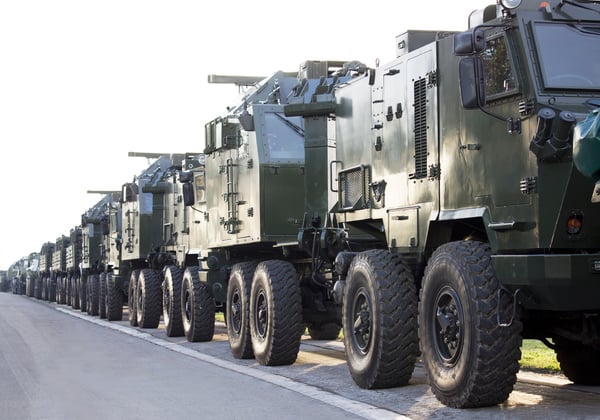
If you’ve ever been to a military museum, you may have taken a tour of a tank or an armored truck. The huge hatches on those vehicles are very heavy -- if you’ve lifted one, you know what we’re talking about.
If you’re in a situation where time matters, those heavy hatches might be an impediment or cause serious injury if you’re not careful. But, there are a few ways that engineers can mitigate the weight of those hatches to make using them easier and safer. Enter motion control hinges.
Keep reading to learn how motion control and heavy-duty hatch hinges can improve armored and military vehicles.
The Best Heavy-Duty Hatch Hinges for Armored Vehicles
Depending on the type of military or armored vehicle we’re talking about, hatch weight will vary. For example, some tanks have hatches that range from 15-40 mm thick, and some are so heavy that they have a hydraulic system to lift them.
But, what about for armored vehicles that aren’t specifically used for military purposes? Bank transport trucks or police vehicles are good examples, and chances are they aren’t large enough to require external hydraulic systems.
To help mitigate the weight of the hatches, armored vehicle manufacturers can incorporate motion control solutions, mainly heavy-duty hatch hinges.
Counterbalances? Nope
Counterbalance hinges might seem like a good option for alleviating the weight of heavy hatches. After all, they’re used on industrial machinery and lab equipment to make 70 lbs. feel like 2 lbs.
However, implementing counterbalances on vehicles can be tricky. When the vehicle is parked on a flat surface, the counterbalance will work fine. If the vehicle is parked on an incline, or moves while the hatch is open, counterbalances will react differently and not always in a favorable manner.
Counterbalances incorporate various springs to offset the weight of a lid or hatch as it moves through the opening/closing cycle. A lot of that process has to do with the angle of the hinge and gravity.
So, if counterbalances are off the table, what other solution is there for heavy hatches?
Spring-Assist Hinges for Heavy-Duty Hatches
The spring-assist hinge has a wide array of applications, on everything from drum smoker lids to medical equipment. The reason it’s so widely used is because not only does it provide some of the same weight mitigation as counterbalances, it also comes at a fraction of the cost.
For armored vehicles like bank transport trucks, opening or closing the hatch gradually is the most important feature of the hinge. If the manufacturer doesn’t need a soft-open, soft-close, or lid stay mechanism, then there’s no sense incorporating a counterbalance hinge.
Spring-assist hinges can reduce the weight of a lid or hatch significantly, making opening and closing fast and easy. That trait alone makes spring-assist hinges desirable for military truck manufacturers -- they can save lives.
Advantages of Heavy-Duty Hatch Hinges
Using the right kind of heavy-duty hatch hinges can bring a heap of benefits, whether the hatch is used on armored vehicles or for marine applications.
These benefits include:
- Improved safety
- Long cycle life
- Ease of use
- Ability to design for specific environments
Safety
Traditionally, some hatches for armored vehicles or other heavy-lidded applications used gas springs, like the kind you see on car trunks.
These gas springs are often prone to failure, but mechanical hinges are far less likely to experience a catastrophic failure. When a hinge is being used for such a critical application, safety is of the utmost importance.
Long Cycle Life
Spring assist hinges can be customized to last for over 100,000 cycles depending on the application. This lowers cost because the hatch hinges won’t have to be replaced nearly as often. Military armored vehicles can last a long time, so the hinges should as well.
Ease of Use
This benefit is a big one, and we’ve mentioned it before. Reducing the effort required to open and close a hatch plays an important role in the day-to-day use of the armored vehicle, whether it’s out on the battlefield or in a civilian setting.
Armored Vehicle Design and the Environment
One of the most common reasons gas springs fail is because of temperature. In cold weather, gas springs are less responsive and require more effort to work.
Mechanical springs, however, aren’t impeded by temperature, and work the same whether it’s 100º F or -10º F.
Aside from temperature, spring-assist hinges can be designed to withstand humid or wet environments. If the hinge will be used in a particularly moist area, the hinge will be made with stainless steel instead of regular steel. The coatings applied to these hinges will also help protect them from corrosion.
Spring-Assist Is Also Good For….
OK, so motion control hinges are great for heavy-duty hatches ... but how else can spring-assist hinges improve armored vehicle design?
Well, for starters, spring-assist hinges can be designed for a variety of weights -- they don’t all have to be exorbitantly heavy applications.
In the back of bank transport trucks, spring-assists could be implemented on fold-down shelving. The ability to raise or lower shelves can save space and open possibilities for different payloads (think gold bars instead of bags of cash, like a James Bond movie).
Thinking about personnel transport vehicles, spring-assist hinges can be used for fold-down seating. Much like the shelving, this design can save space and improve mobility in the back of police or prison transport vehicles.
The Best Heavy-Duty Hatch Hinges for Armored Vehicle Design
Using spring-assist hinges for armored vehicles, bank transport trucks, and military applications improves safety while remaining an affordable hinge solution. Above all else, the safety of the tank operators or bank truck drivers should be at the forefront of the armored vehicle design.
To learn more about how heavy-duty hinges make a difference for industries across the board, check out our new resource page!
.png?width=12000&height=2033&name=WeberKnappLogo_white%20(1).png)


